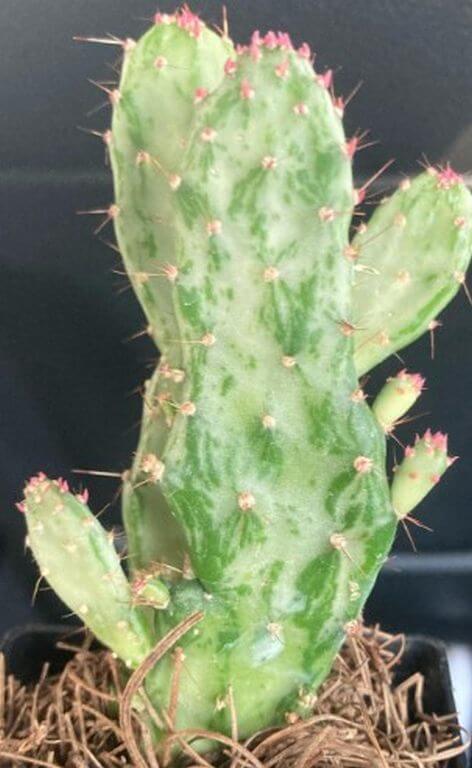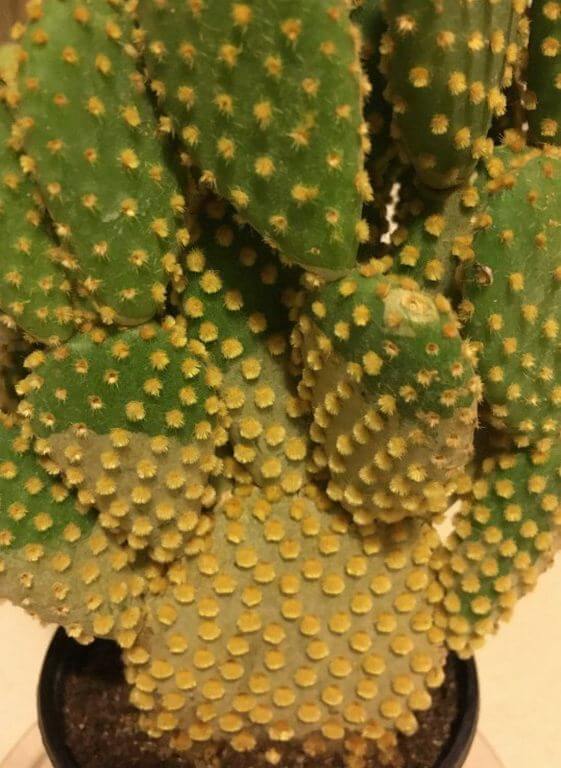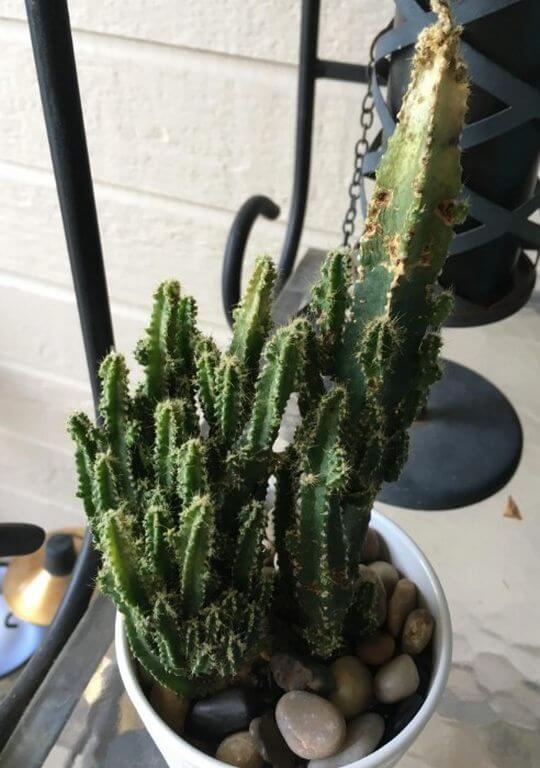- It is important to find the main reasons the cactus goes white.
- Key things affecting the cactus health are too much sun, wrong water amounts, and bugs attacking.
- Quick treatments can stop more harm and help it heal.
- Keeping the right conditions is key in cactus care.
- Checking the roots and plant regular is needed to see issues early.
- Knowing good care helps us avoid and fight the cactus getting red and rotting.
Understanding Cactus Turning White
When we see a cactus turning white its mean with wrong colors or white parts, our first worry is not just how it looks but how the plant feels inside.
These signs you can see usually mean there is strain underneath like too much sun, too much or little water, fungus disease, or bugs attacking.
To keep our cactus strong and well, it is important we know these danger signs.
Also, a cactus staying wet and doing good in hard, dry places can have trouble with this when food is missing or conditions are bad. Wrong colors may show these problems, making us look close at how we care for our cactus.
- Too much sun can burn the cactus, getting in the way of the plant’s sun-eating.
- Some water then no water leads to root rot if wet too long or dryness if not wet enough.
- Fungus disease shows with wrong colors and spreads quick without help.
- Bugs like mealybugs and spider mites weaken the cactus, making pale spots on its skin.
- Not enough air movement and the wrong type of soil make bad conditions for growing.
| Cause | Description | Source | Initial Action |
|---|---|---|---|
| Pest Infestation | White cottony patches indicating the presence of pests like mealybugs. | Insects such as cactoblastis cactorum and mealybugs. | Manual removal and application of organic insecticides. |
| Fungal Diseases | Mold or mildew forming white spots on cactus skin. | Excess moisture and poor air circulation. | Reducing watering frequency and improving ventilation. |
| Sunburn | Bleached or pale areas of tissue where the plant has been overexposed to sunlight. | Direct, intense sunlight for prolonged periods. | Relocating the plant to an area with indirect or filtered light. |
| Overwatering | Soggy soil leading to soft, discolored spots on the cactus. | Watering too frequently or soil with poor drainage. | Adjusting the watering schedule and ensuring proper soil drainage. |
Identifying and Isolating the Affected Parts
- Watering Practices: Adjust frequency and volume according to the cactus species and current climate.
- Sunlight Exposure: Ensure cacti receive sufficient hours of natural light without experiencing adverse effects like sunburn.

Ensuring Proper Soil and Air Circulation
| Condition | Diagnosis | Immediate Response |
|---|---|---|
| Root Rot | Discolouration and softening of roots | Enhance drainage and reduce watering frequency |
| Pest Infestation | Visible pests or damage on cactus skin | Apply appropriate fungicide or pest solution |
| Sunburn | Whitening or crisping at the top and sides facing the sun | Adjust sunlight exposure to prevent direct harsh rays |
| Air Flow Restriction | Stagnation around the plant, increased moisture | Reposition to enable better air circulation |
Good Ways To Treat White Cactus
- Pest Management: Use targeted pesticides to mitigate pest infestations, taking care to apply according to manufacturer instructions.
- Fungal Control: Select fungicides tailored for cacti, ensuring they address the particular fungal strains causing infection.
Home Remedies and Organic Solutions
- Mix neem oil with water and a mild soap for an effective natural pesticide spray.
- Prepare a baking soda and water solution as a fungicide for mild fungal infections.
- Introduce beneficial insects like ladybugs to control pest populations naturally.
The Importance of Quarantine for Infected Cactus
| Quarantine Action | Benefit |
|---|---|
| Isolation of Infected Plants | Prevents disease spread to healthy specimens |
| Close Monitoring | Allows for targeted treatment application without exposing other plants |
| Controlled Environment | Enables adjustment of conditions to aid recovery |
Conclusion
In caring for cacti, white spots are no small matter – they push us to act attentive and quick. We saw that reacting fast with the right test, following first steps, and using helpful treatments means a cactus has a chance to recover. A comeback is possible, and with hard work, our prickly friends can feel good again.
Caring for plants needs to go on, requiring us to watch close and follow best methods. Our job does not end with treatment, it extends to stopping issues before they start. We must make an environment strong for health, with control of moisture, light conditions, and air flow to lessen strain on the plants. This defense protects against future sicknesses.
Let’s agree that knowing what we know and using good practices gives us power over how our plants feel. Addressing small details like help from outside, warning signs, and steps to aid – it’s a song we lead with total respect for nature’s strength to endure. Therefore, in watching over them, cacti don’t just survive; they have the power to really thrive.
FAQ
What causes my cactus to turn white?
Your cactus may turn white due to several reasons, including fungal infections such as cactus erythema, pest infestations including cactoblastis cactorum, overexposure to sunlight causing sunburn, or environmental stressors like incorrect moisture levels leading to rot.
How can I tell if my cactus has a fungal infection?
Symptoms of a fungal infection in cacti include the presence of white spots, a powdery mildew-like substance, or discoloration on the plants. The plant may appear unhealthy, and the affected areas may show signs of rot or decay.
What should I do when I first notice white spots on my cactus?
The first step would be to identify and isolate the affected parts to prevent the spread of any potential infection. Then, adjust your watering practices to ensure the cactus isn’t receiving too much or too little water and adjust its exposure to sunlight to prevent sunburn and provide the optimal amount of natural light.
How can I improve air circulation for my cactus?
Enhance air circulation by placing your cactus in a well-ventilated location, ensuring that it’s not too crowded by other plants. You can also use a gentle fan to increase air movement around the cactus, but avoid placing it in direct line with the airflow to prevent dehydration.
Should I use chemical treatments for my whitening cactus?
If the whitening of your cactus is due to pests or a fungal infection, the careful selection of pesticides or fungicides may be necessary. Ensure to choose the appropriate treatment based on the specific pests or fungi identified and always follow the manufacturer’s instructions to avoid causing further harm to the plant.
Are there natural remedies for white spots on cacti?
Yes, there are natural remedies for treating white spots on cacti. Home remedies may include neem oil, insecticidal soap, or making a homemade spray with mild soap and water. Introducing natural predators that target specific pests can also be an organic solution.
Why is quarantine important for a cactus with white spots?
Quarantining an infected cactus is vital to prevent the spread of diseases or pests to other plants. It allows you to treat the affected cactus without risking the health of the rest of your collection and makes it easier to monitor the plant’s response to treatment.
How can I prevent my cactus from turning white?
Preventing your cactus from turning white involves regular monitoring for signs of stress or infestation, maintaining proper watering and sunlight exposure, ensuring good air circulation and drainage in the soil, and being proactive in pest management. Additionally, providing balanced nutrition can help strengthen the plant’s natural defenses.



